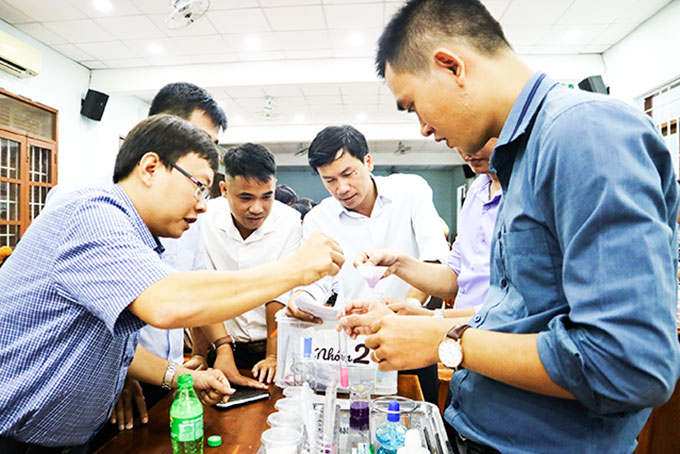
STEM is the acronym for Science, Technology, Engineering and Mathematics. STEM integrates them into a cohesive learning paradigm based on real-world applications...
STEM is the acronym for Science, Technology, Engineering and Mathematics. STEM integrates them into a cohesive learning paradigm based on real-world applications. STEM-based teaching approach is being applied initially in some high schools in Khanh Hoa Province.
Teaching based on real-world applications
STEM education has been known worldwide and recently applied widely in Vietnam. The Ministry of Education & Training has provided training for school managing and teaching staff, according to Nguyen Thi Thu Huong, a STEM-based EIE curriculum trainer and researcher at NEMO Science Museum, Netherlands.
STEM is known as an interdisciplinary and applied approach that develops 4 subjects collectively based on actual application instead of teaching the four disciplines as separate and discrete subjects. For example, in a physics class about the formula speed = distance/time, a STEM-related topic “jet, creating non-motorized racing vehicle” will be given. Students will be asked to measure the distance, use a stopwatch to measure the time to calculate the speed of the vehicles they have created. Non-motorized racing competitions integrated with environmental protection may be held to inspire learner interest.

|
STEM education supports broadening the study of engineering within each of the other subjects. STEM mainly helps students to explore how what they have learned applies to real world situations. The most important thing is to motivate learning and getting access to science. In the new curricula, creative experience activities are compulsory, focusing on integration of knowledge and skills of many fields in reality. STEM is one of the hands-on learning activities, according to Le Dinh Thuan, Vice-Director of Khanh Hoa Department of Education & Training.
Teachers interested in STEM lessons
A STEM lesson is divided into 3 levels: teaching subjects using STEM approach, organizing hands-on learning activities and doing scientific and technical research. A STEM lesson plan is made following specific steps with clearly-designed purposes, content and educational products required for each activity.
As many as 80 teachers have just attended a STEM training workshop held by Khanh Hoa Department of Education & Training and experienced interesting hands-on learning activities in a model lesson. In a lesson about indicators, under the teacher’s guidance, within 20 minutes, groups of learners used a red cabbage indicator and other materials to change colors of various solutions as well as processed colorful drinking water for the school camp. The classroom environment became exciting as learners were eager to discuss, do experiment and excitedly wait for experiment results.
Teacher Dang Ngoc Tien, To Van On High School, Van Ninh District says such demonstration lessons have helped teachers know how to organize hands-on learning activities effectively to motivate learning and facilitate learners’ access to real-life aspects of engineering practices, promoting chances of using recycled materials to create educational products at school.
STEM is an effective teaching method, showing students how to bring their knowledge and skills to produce real things they like, according to Teacher Nguyen Huy Chuong, Nguyen Thai Binh Junior High School, Khanh Vinh District.
There is no STEM curriculum so far. The Ministry of Education & Training has just issued a draft of building STEM-based activities at school. Despite some advantages, there are some challenges when applying STEM education at school due to limited facilities and time required. Small classrooms with many students are a real challenge for a teacher to take control of the class. Initially, STEM-based interdisciplinary approach activities may be organized as materials for making teaching products seem quite cheap, simple and easy to find, adds Teacher Dang Ngoc Tien.
There are some challenges when applying STEM education at schools due to lack of facilities and limited teaching ability. Especially, in a school where nearly 70% of students are ethnic minority people, their communication and teamwork skills are limited. Therefore, demonstration lessons may be helpful as an immediate STEM approach for both teachers and students to get access to the new learning method, adds Teacher Nguyen Huy Chuong.
H.Ngan
Translated by N.T




